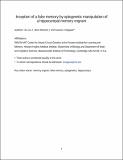| dc.contributor.author | Liu, Xu | |
| dc.contributor.author | Ramirez Moreno, Steve | |
| dc.contributor.author | Tonegawa, Susumu | |
| dc.date.accessioned | 2015-08-13T20:00:40Z | |
| dc.date.available | 2015-08-13T20:00:40Z | |
| dc.date.issued | 2013-12 | |
| dc.identifier.issn | 0962-8436 | |
| dc.identifier.issn | 1471-2970 | |
| dc.identifier.uri | http://hdl.handle.net/1721.1/98083 | |
| dc.description.abstract | Memories can be easily distorted, and a lack of relevant animal models has largely hindered our understanding of false-memory formation. Here, we first identified a population of cells in the dentate gyrus (DG) of the hippocampus that bear the engrams for a specific context; these cells were naturally activated during the encoding phase of fear conditioning and their artificial reactivation using optogenetics in an unrelated context was sufficient for inducing the fear memory specific to the conditioned context. In a further study, DG or CA1 neurons activated by exposure to a particular context were labelled with channelrhodopsin-2 (ChR2). These neurons were later optically reactivated during fear conditioning in a different context. The DG experimental group showed increased freezing in the original context in which a foot shock was never delivered. The recall of this false memory was context specific, activated similar downstream regions engaged during natural fear-memory recall, and was also capable of driving an active fear response. Together, our data demonstrate that by substituting a natural conditioned stimulus with optogenetically reactivated DG cells that bear contextual memory engrams, it is possible to incept an internally and behaviourally represented false fear memory. | en_US |
| dc.description.sponsorship | National Institutes of Health (U.S.) (Grant R01-MH078821) | en_US |
| dc.description.sponsorship | National Institutes of Health (U.S.) (Grant P50-MH58880) | en_US |
| dc.language.iso | en_US | |
| dc.publisher | Royal Society | en_US |
| dc.relation.isversionof | http://dx.doi.org/10.1098/rstb.2013.0142 | en_US |
| dc.rights | Creative Commons Attribution-Noncommercial-Share Alike | en_US |
| dc.rights.uri | http://creativecommons.org/licenses/by-nc-sa/4.0/ | en_US |
| dc.source | Tonegawa via Courtney Crummett | en_US |
| dc.title | Inception of a false memory by optogenetic manipulation of a hippocampal memory engram | en_US |
| dc.type | Article | en_US |
| dc.identifier.citation | Liu, X., S. Ramirez, and S. Tonegawa. “Inception of a False Memory by Optogenetic Manipulation of a Hippocampal Memory Engram.” Philosophical Transactions of the Royal Society B: Biological Sciences 369, no. 1633 (December 2, 2013): 20130142–20130142. | en_US |
| dc.contributor.department | Massachusetts Institute of Technology. Department of Biology | en_US |
| dc.contributor.department | Massachusetts Institute of Technology. Department of Brain and Cognitive Sciences | en_US |
| dc.contributor.department | Picower Institute for Learning and Memory | en_US |
| dc.contributor.department | RIKEN-MIT Center for Neural Circuit Genetics | en_US |
| dc.contributor.approver | Tonegawa, Susumu | en_US |
| dc.contributor.mitauthor | Liu, Xu | en_US |
| dc.contributor.mitauthor | Ramirez Moreno, Steve | en_US |
| dc.contributor.mitauthor | Tonegawa, Susumu | en_US |
| dc.relation.journal | Philosophical Transactions of the Royal Society B: Biological Sciences | en_US |
| dc.eprint.version | Author's final manuscript | en_US |
| dc.type.uri | http://purl.org/eprint/type/JournalArticle | en_US |
| eprint.status | http://purl.org/eprint/status/PeerReviewed | en_US |
| dspace.orderedauthors | Liu, X.; Ramirez, S.; Tonegawa, S. | en_US |
| dc.identifier.orcid | https://orcid.org/0000-0003-2839-8228 | |
| dc.identifier.orcid | https://orcid.org/0000-0002-6697-8330 | |
| mit.license | OPEN_ACCESS_POLICY | en_US |
| mit.metadata.status | Complete | |
